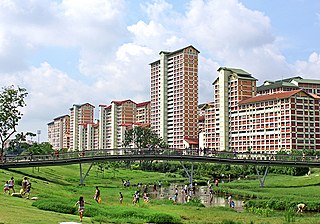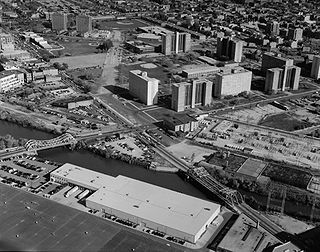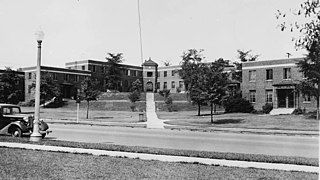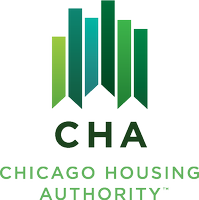
The United States Department of Housing and Urban Development (HUD) is one of the executive departments of the U.S. federal government. It administers federal housing and urban development laws. It is headed by the secretary of housing and urban development, who reports directly to the president of the United States and is a member of the president's Cabinet.

Public housing is a form of housing tenure in which the property is usually owned by a government authority, either central or local. Although the common goal of public housing is to provide affordable housing, the details, terminology, definitions of poverty, and other criteria for allocation vary within different contexts. Within the OECD, social housing represents an average of 7% of national housing stock (2020), ranging from ~34% in the Netherlands to less than 1% in Colombia.

Cabrini–Green Homes was a Chicago Housing Authority (CHA) public housing project on the Near North Side of Chicago, Illinois. The Frances Cabrini Rowhouses and Extensions were south of Division Street, bordered by Larrabee Street to the west, Orleans Street to the east and Chicago Avenue to the south, with the William Green Homes to the northwest.
Section 8 of the Housing Act of 1937, often called Section 8, as repeatedly amended, authorizes the payment of rental housing assistance to private landlords on behalf of low-income households in the United States. 68% of total rental assistance in the United States goes to seniors, children, and those with disabilities. The U.S. Department of Housing and Urban Development manages Section 8 programs.

Techwood Homes was an early public housing project in the Atlanta, Georgia in the United States, opened just before the First Houses. The whites-only Techwood Homes replaced an integrated settlement of low-income people known as Tanyard Bottom or Tech Flats. It was completed on August 15, 1936, but was dedicated on November 29 of the previous year by U.S. President Franklin D. Roosevelt. The new whites-only apartments included bathtubs and electric ranges in each unit, 189 of which had garages. Central laundry facilities, a kindergarten and a library were also provided. Techwood Homes was demolished in advance of the 1996 Olympics and is now Centennial Place Apartments.
HOPE VI is a program of the United States Department of Housing and Urban Development. It is intended to revitalize the most distressed public housing projects in the United States into mixed-income developments. Its philosophy is largely based on New Urbanism and the concept of defensible space.

The Housing Authority of New Orleans is a housing authority in New Orleans, Louisiana, tasked with providing housing to low-income residents.

The Chicago Housing Authority (CHA) is a municipal corporation that oversees public housing within the city of Chicago. The agency's Board of Commissioners is appointed by the city's mayor, and has a budget independent from that of the city of Chicago. CHA is the largest rental landlord in Chicago, with more than 50,000 households. CHA owns over 21,000 apartments. It also oversees the administration of 37,000 Section 8 vouchers. The current acting CEO of the Chicago Housing Authority is Tracey Scott.

The Housing Act of 1937, formally the "United States Housing Act of 1937" and sometimes called the Wagner–Steagall Act, provided for subsidies to be paid from the United States federal government to local public housing agencies (LHAs) to improve living conditions for low-income families.
Residential segregation is the physical separation of two or more groups into different neighborhoods—a form of segregation that "sorts population groups into various neighborhood contexts and shapes the living environment at the neighborhood level". While it has traditionally been associated with racial segregation, it generally refers to the separation of populations based on some criteria.

In the United States, subsidized housing is administered by federal, state and local agencies to provide subsidized rental assistance for low-income households. Public housing is priced much below the market rate, allowing people to live in more convenient locations rather than move away from the city in search of lower rents. In most federally-funded rental assistance programs, the tenants' monthly rent is set at 30% of their household income. Now increasingly provided in a variety of settings and formats, originally public housing in the U.S. consisted primarily of one or more concentrated blocks of low-rise and/or high-rise apartment buildings. These complexes are operated by state and local housing authorities which are authorized and funded by the United States Department of Housing and Urban Development (HUD). In 2020, there were one million public housing units. In 2022, about 5.2 million American households that received some form of federal rental assistance.
In 1996, The Atlanta Housing Authority (AHA) created the financial and legal model for mixed-income communities or MICs, that is, communities with both owners and renters of differing income levels, that include public-assisted housing as a component. This model is used by the U.S. Department of Housing and Urban Development's HOPE VI revitalization program. As of 2011, it has resulted in all housing projects having been demolished, with partial replacement by MICs.
In 1994 the Atlanta Housing Authority, encouraged by the federal HOPE VI program, embarked on a policy created for the purpose of comprehensive revitalization of severely distressed public housing developments. These distressed public housing properties were replaced by mixed-income communities.

The definition of mixed-income housing is broad and encompasses many types of dwellings and neighborhoods. Following Brophy and Smith, the following will discuss “non-organic” examples of mixed-income housing, meaning “a deliberate effort to construct and/or own a multifamily development that has the mixing of income groups as a fundamental part of its financial and operating plans” A new, constructed mixed-income housing development includes diverse types of housing units, such as apartments, town homes, and/or single-family homes for people with a range of income levels. Mixed-income housing may include housing that is priced based on the dominant housing market with only a few units priced for lower-income residents, or it may not include any market-rate units and be built exclusively for low- and moderate-income residents. Calculating Area Median Income (AMI) and pricing units at certain percentages of AMI most often determine the income mix of a mixed-income housing development. Mixed-income housing is one of two primary mechanisms to eliminate neighborhoods of concentrated poverty, combat residential segregation, and avoid the building of public housing that offers 100% of its housing units to those living in poverty. Mixed-income housing is built through federal-, state-, and local-level efforts and through a combination of public-private-non-profit partnerships.
Charles Forrest Palmer was an Atlanta real estate developer who became an expert on public housing and organized the building of Techwood Homes, the first public housing project in the United States. He would later head up both the newly created Atlanta Housing Authority and the Chamber of Commerce.

McCormack Baron Salazar is an American real estate development firm based in St. Louis, Missouri specializing in economically integrated urban neighborhoods with more than $4.23 billion invested in affordable and mixed-income housing projects. McCormack Baron Salazar provides development as well as ongoing property management services, development financing and tax credit services, and asset management services. </ref>
Moving to Work (MTW) is a demonstration program for public housing authorities (PHAs) that provides them the opportunity to design and test innovative, locally designed strategies that use Federal dollars more efficiently, help residents find employment and become self-sufficient, and increase housing choices for low-income families. MTW gives PHAs exemptions from many existing public housing and voucher rules and more flexibility with how they use their Federal funds. PHAs can use special funding formulas for MTW agencies and permit agencies to shift funds between the programs or to other uses.

Churchill is a neighborhood in Holyoke, Massachusetts located to the south of the city center, adjacent to the downtown. Its name is a geographic portmanteau as the area was historically known as the Church Hill district prior to its extensive development in the early twentieth century. Located at the southwestern edge of the downtown grid, the area served as housing for mill workers in the late nineteenth and early twentieth century and today contains 166 acres (67 ha) of mixed residential and commercial zoning, including a number of historical brick tenements as well as the headquarters of the Holyoke Housing Authority, Holyoke Senior Center, Churchill Homes public housing, and the Wistariahurst Museum.
The Olympic Legacy Program was an initiative taken in effort to revitalize many of Atlanta’s public housing projects in the early 1990s in preparation for hosting the 1996 Olympic Games. The initiative, guided by the principals of “new urbanism” was proposed as a way to transform thirteen former projects scattered throughout the city. The initiative began with Techwood Homes in downtown Atlanta, Clark Howell Homes, and continuing to several other projects in each zone. The program was led by former Atlanta Housing Authority (AHA) CEO Renee Glover. While the project's ultimate effect was to reduce the concentration of poverty in the city, and improve neighborhoods, employment and education opportunities, finding housing for some of the poor shifted to suburban housing which lacked many of the social services of government housing.
The Troy Housing Authority (THA) is a public agency of the city of Troy, New York that provides subsidized public housing to low- and moderate-income families and individuals, and is the pass-through agency for funding from various housing-related federal programs.
















